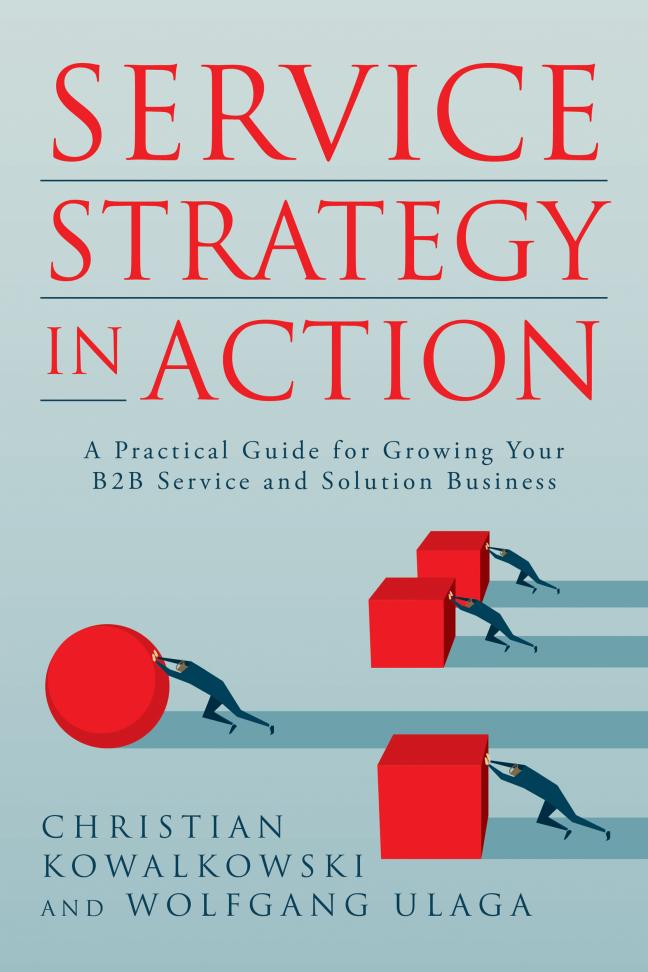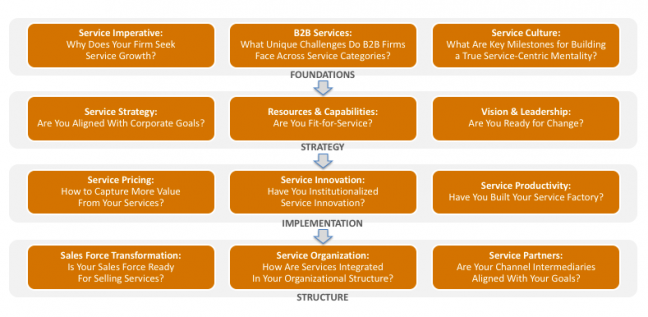In our new book, Service Strategy in Action (S2iA), Professor Wolfgang Ulaga, AT&T Professor of Services Leadership and Co-Executive Director at the Center for Services Leadership at Arizona State University, and I show how to shift from a goods-centric business model to a service-savvy one.
For over a decade, we have accompanied numerous firms on their journeys from focusing on manufacturing and selling products to providing services and customer solutions in a broad array of industries and markets. We distilled what we learned into a 12-step road map, which provides clear directions for crafting a competitive service strategy and putting it into practice. We recognise that all companies have different starting points and goals for their service businesses, so we tailored the road map to make it possible for managers to focus on the most pressing issues.
When service-growth strategies work, the payoffs are impressive, and firms often discover that their new activities make more money than products. But for every success story, numerous cautionary tales remind us that this move involves more than a few cosmetic adjustments. Without giving this strategic initiative serious thought, and without methodologically managing the change process, our research has found that the transition is doomed to fail and companies struggle to turn a profit from their service growth initiative.
Our intention in this book is therefore to provide decision makers with the tools they need to craft a competitive service strategy and put it into practice. Readers can employ our proprietary road map and use methods and frameworks for each step in their own firms to navigate the transformation.
The first part of the road map tackles the very foundations of a service business: why to move into services and how to embed a true service-centric culture in your organisation. The second part deals with strategic issues: how to drive change and align your service strategy with corporate goals, and determine if your company is “fit-for-service.” Then we discuss how to come to grips with implementation: how to make the most of your existing services, innovate and create value-added services and solutions beyond your products, and build the service factory. Finally, we show how to build the structure needed: transforming your product-centric sales force into a service-savvy sales organisation, designing an organisational structure that promotes service growth, and aligning your interests with distributors and partners.

Our 12-Step Roadmap to Service Growth
Building a true service culture
Once you understand why to move into service and what the main roadblocks are, consider the culture that supports successful service enterprises and how to venture into the service space. In working with managers in industrial and professional services companies, we have seen over the years that a strong service culture serves as a powerful enabler of successful service growth.
Product firms that neglect to assess culture often struggle to implement services, and sometimes abandon the effort. A company can burn a lot of energy trying to move forward with services if its culture is product-centric, because culture underpins the organisation. We have identified six misconceptions that are hurdles to transitioning from a product-centric to a service-savvy culture. Here are the hurdles, and the signs that you still need to jump over them:
-
A product-centric mind-set — Your marketing efforts focus on things that come in boxes. Your accounting system is designed for physical resources. R&D works on solutions that are objects. You compensate your sales team based on boxes moved.
-
An absence of deep customer insights — You are using a distributer network, and those channels – not you — have the close and valuable relationships with your customers.
- A lack of understanding and using the co-creation concept — You still think value is created in your factory and you can’t see how customers can partner with you to co-create a service offer.
-
The right rules are factory rules — You are uncomfortable with the new rules of service production that upset traditional factory values like standardisation and quality control.
-
It’s all about CAPEX — You are focused on capital expenditures and selling customers equipment, rather than helping them solve operational challenges.
-
Working through channels — You have built a strong channel network, and you don’t want to think that it may be necessary to assume more control over channels – even owning them outright.
Making the move to services, then, is a process that starts with the culture at the very core of your business. Changing culture is never easy, and understanding that fact improves a company’s chances of transforming their product-centric culture to service-focused culture. Four stages mark the way. Not every company starts at the same point, so it’s useful to figure out where your firm is on the map, and what actions and initiatives will be required to move to the next step.
Step One: The Service Desert – Many firms are what we call service-myopic. They are aware of service, but they see it as an after-sale add-on. Firms deeply grounded in the service desert often consider providing spare parts or repairing equipment as a substantial part of their service business. This is a narrow focus view that obscures opportunities that could result in double-digit revenue growth.
Step Two: The Dark Tunnel – A company ramps up investment in service, but results are slow. It’s a “bitter pill” experienced by many companies going through this transition. Decision makers must understand that a critical mass of services is needed before reaping benefits. A short-term focus only can lead to sacrificing long-term growth.
Step Three: Promising Light – In this stage, companies that seized service opportunities early on are experiencing quick wins. Some firms emerge into this stage without even going through the dark tunnel. When it happens, welcome revenues turn up, and the proponents of the services transition have powerful evidence to persuade others across the organisation.
Step Four: Bright Landscape – This is the destination! The company has devoted sufficient resources and people top its cultural transformation, and the new service business is a source of profit and growth.
Would you like to know more? Please visit us on www.ServiceStrategyInAction.com to find out more and continue the conversation. We are sincerely interested in your comments and hope that our book will initiate a fruitful dialogue on this topic we all are so passionate about!
Research Fellow
